Geoffrey Ernest Katantazi Mukasa, Kampala, Uganda (1954-2009)
“Terrifying, No, Terrified” was the description used by David Kaiza, an art critic in Kampala, Uganda to describe the works of Geoffrey Mukasa. Coming from a war-torn country like Uganda and given the circumstances of the 1970s in Kampala, one has to think he was giving a sense of what history means to his people.
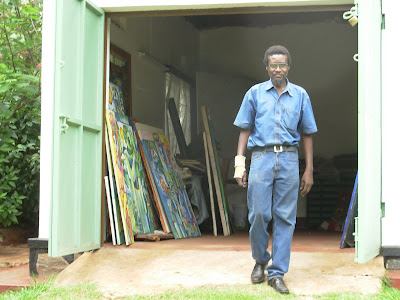
Were his eyes a statement on the permanent state of shock and horror his country seemed to live with from one decade after another? If the eyes are the doorway to the soul, then his soul is wide open. In his art, you find an abstract vision of the world. This is hardly what you would expect to find in the art of a man born and raised by one of the more prominent families in society. Then again, he was born and raised during a time of suffering and political upheaval under the harsh rule of Idi Amin.
In 2003, it was said that Mukasa is a co-creator in his own right. He looks at life and what it has to offer, appreciates it and uses his fertile imagination to create images.
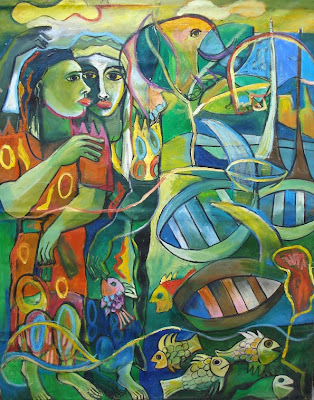
Ladies of the Lake 5’ x 4’ - unfinished canvas
In his own words, Mukasa described his art in 2004, “The philosophy of my artwork lies mainly in the human figure and the head reflected in different settings of various colors, semi-abstract surroundings with an inner light that consolidates the feeling of depth and the fourth dimension of time.”
Kaiza was awestruck with Muhasa’s work, saying that he had not seen art like his before – the radiance of the colors, the shock of seeing humans with the dear-in-headlight eyes that you don’t forget. Then, there were all the chickens and bottles of beer and fruit. His work was truly unique and definitely unlike the modern art that was being produced in other parts of East Africa.
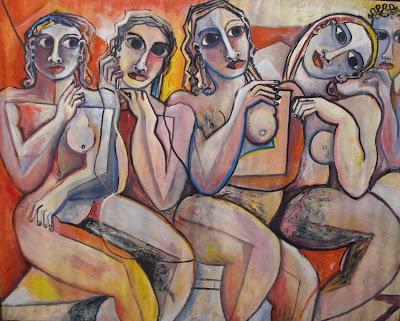
5 ladies, Nudes, 4 x 6 feet, oil on canvas and barkcloth, 2009
Blue Nude, 90 x 60 cm, collage 1996

Broken Marriage, 1997, oil on canvas, 5 x 4 feet, RM
The Makerere University Art School has its trademark stamp of structure and composition shown in the work of their students. Modern Ugandan art is easily recognized for the uniformity of composition. Then there is the work of Mukasa, a combination of abstract and primitive, stylized and using colors unlike most of the other African artists.
Kaiza said, “He worked using a palette consisting mostly of blues but, his colors were very alive. This is common for most artists in Uganda. But, his colors were extremely vibrant, more so than other artists. Then there was the matter of his subjects and this is how his work seemed old. It is the eyes in his work that strike and remain with you. Wide and shocked, they stare straight at and through you. Immediately I thought of the Gorgon and through it, the Greek classical figures. The colors did not come from Uganda, I could see that instantly. Though painters have often commented on the intensity of light in Africa, Mukasa’s palette seemed to depict to me, not what he saw around him rather it seemed to depict states of the mind.” Colors and the eyes intermixed making his work appear psychological, almost spiritual. Of the abundance of mangoes and oranges and bananas he painted in hot colors. It was suggested that these represented fertility and abundance. The most striking part of his art is the face, especially, the intense and terrifying eyes. The faces tend to be long with the nose drooping sharply below the eyes.
Lady with Fish, 1 x 2 feet, 2006
Market Vendors, 5 x4 feet,2005, World Bank Kampala Office
If his use of the human eyes owes much to his Indian education, then he used them to tell a darker tale, for Indian depictions of the human face are generally of warmth and spiritual ecstasy. His are of figures that seem to have lost peace and appear to ask why they must not have it. Kaiza noted that Mukasa painted his figures with the bright blues and lavenders and violets, the same that you see on Hindu gods. “Because he trained in India, you see that combination of the Indian approach to art and his Ugandan approach,” Josephine Mukasa, an art curator, says. “I don’t know if it is psychological. He lived in Uganda and we are very colorful people. It is an intermixing of different approaches, and is unique in this country.”
After learning of Mukasa's death, Frank Whalley, who runs Lenga Juu in Nairobi, Kenya said, “It is too soon to see Mukasa's work in context and to establish if it will continue to support his reputation as one of Uganda's major artists, or if it will become the quiet pleasure of a knowledgeable few. Mukasa had already been a popular and well followed artist for 20 years. As stated by Maria Fisher of the Gallery at Tulifanya, "For many years, Mukasa has proven himself to be one of the most prolific artists from East Africa." The graphic element in his work is strong and can be seen in his orderly assemblage of planes and color fields. His oils are bold and direct. As Stanley Spencer saw Christ in the English village of Cookham, and used the local scenery as a backdrop to the Testament, so Mukasa uses the landscape around Kampala combined with elements of urban life as a superficial entry point from which to project a deeper, more mystical message, both allegorical and allusive. I feel Mukasa found his voice in a small painting of fish, brightly colored and darting inquisitively over the canvas. Viewing the picture was rather like peeking into a brightly lit display tank. Was this Mukasa still searching for a clear and unique statement? And will his quest inspire others eventually to find their own paths, too? Only time will tell us for certain.”

In his later years, Mukasa was a quiet, shy person who did not like to attract much attention. Life as an artist was not easy. This could be because his family did not approve of his career or because of several misunderstandings with his neighbors.

Bio:
Geoffrey Mukasa was born in 1954 in Mulago, in the center of Kampala, the capital of Uganda to one of Uganda’s most prominent doctors. He grew up at in the palace of Kabaka, who at the time was the regional King of Buganda. Many people expected Mukasa to follow in his father’s footsteps and become a doctor. The murder of his father during Idi Amin's coup brought drastic changes to his life, including leaving Uganda and studying art. He studied for a short while in Kenya before deciding to go to India.
He studied at Lucknow University from 1978 and graduated with a degree in Fine Arts from Lucknow University, India in 1984. India greatly inspired Mukasa, exposing himself to European and Indian aesthetic values. He threw himself into his work with vigor, focusing mainly on human relationships with the environment, interactions between humans and every day living.
After his return to Uganda in 1984, he worked at the National Television station as a graphic artist for the Ministry of Information until he launched his career as a full-time artist. In the early 1990s Mukasa became a key figure in the movement to revive cultural life in Uganda. This cultural movement was seen as a unifying force and an inspiration for the nation’s recovery from years of military dictatorship. This movement was started by Ugandan artists returning from exile as well as emerging new artists. Mukasa was different from the other artists because he was not a product of the local Makare University.
Mukasa’s oldest friends said that he started to do collages in his early years as an artist because there were no classic art materials to be purchased in Kampala. He wanted to create works of art, so he used papers of magazines and lots of other bits and pieces to make collages. Later, when art materials were available, he was enjoyed painting on huge canvases. However, he always went back to collages, creating many wonderful portraits.
Mukasa inspired many artists and is featured in books and articles including "Contemporary Art in Uganda" by Rose-Marie Rychner, and the 'Africa Now' World Bank catalogue.
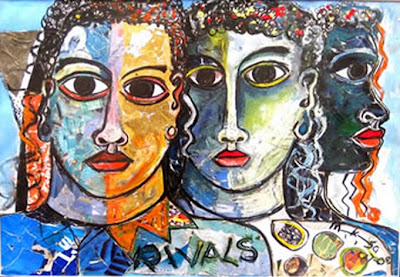
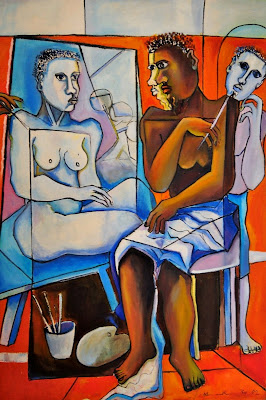
The Model, 2002, oil on canvas, 5 x 4 feet
His reputation grew and he took part in numerous group exhibitions in Europe including Austria, France, Germany and the United Kingdom, as well as in the United States, Canada, Australia, and throughout East Africa. Mukasa's paintings hang in private and public collections in around the world. Locally, his work is displayed at the World Bank in Kampala. In addition to numerous group exhibitions, he has been featured as a solo art show at the Tulifanya Gallery since 1997.
Gallery at Tulifanya:
The Gallery at Tulifanya (formerly the Tulifanya Gallery) was established in 1995 by Canadian artist Beverley Paden and Karen Downing and was acquired in 1999 by Maria Fischer. The principle of the Gallery is to promote contemporary, modern African art by exhibition of works and portfolio management of Ugandan and other East African artists.
Located in Kampala, just minutes from the city center, Tulifanya Gallery is one of the finest Art Galleries in Uganda and offers a wide collection of art, including African Contemporary Art, Tribal Art, African Masks, African Sculptures, and utilitarian objects. Most of the art comes from Uganda, but they have many art pieces from the Congo, Rwanda, Sudan and Kenya.
Every year starts with a group exhibition called “Discoveries” to promote, young upcoming artists and is followed by monthly exhibitions by established artists. Many of these are solo exhibitions. Geoffrey Mukasa has been a featured with a solo exhibition every year since 1997.
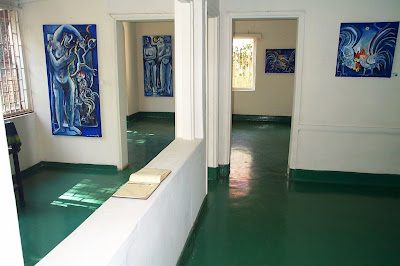
Mukasa's Exhibition at Tulifanya Gallery, 2004
Maria Fischer said, “Mukasa was by far our favorite artist and the only one who had an exhibition every year ever since 1997. He has been one of Uganda’s top artists for more than 20 years.” His remaining art will be available at the art gallery at the end of October. Mukasa passed away on Oct 6, 2009, just 4 days before the opening of his show at the Gallery at Tulifanya.
Fischer said, “I love Mukasa's works because he had a lot of talent and that gift to show things with simple strokes and they are of such a beauty and power and not many artist have this strength and creativity.”
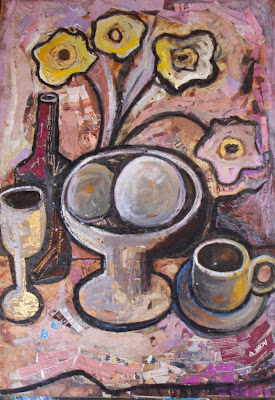
Still life in pink, 88 x 64 cm, collage on board
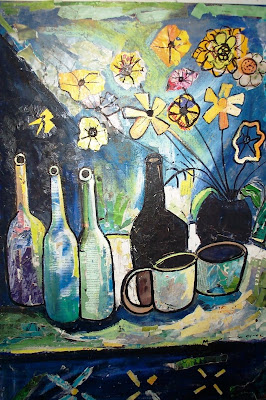
Still life, 85 x 65 cm, multi media collage, 2002
Tulifanya intends to keep Mukasa alive by exhibiting his works in the future. Prints of his work, which would also be one way of supporting his young family. It was not a wasted life, for Mukasa gave his country and art new insights and the number of artists he influenced, and the courage to be individual will live on. There is a special memorial showing of Mukasa’s work at the Gallery at Tulifanya during the month of October. Aka Gallery at Tulifanya is located at Plot 28 Hannington Road, Opposite Crested Towers, Kampala, Uganda. They are open from Tuesday to Friday 10 AM – 5 PM and Saturday from 10 AM to 4 PM
Their phone number is: +256 0414 254 183 and Maria’s email is: akagallery11[at]gmail.com
“The loss of Geoffrey Mukasa is a great loss in the sense that he had his own style,” Josephine says. “He’s still living because of his own unique ism.”
Ray Gutt is the Uganda Co-Editor for Wandering Educators
Most of the photos were supplied by Maria at the Gallery at Tulifanya
